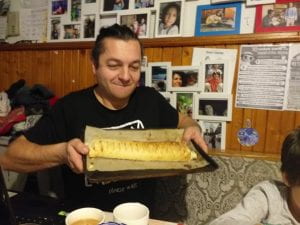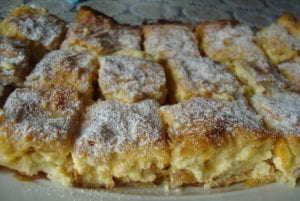Many times some of the most meaningful moments are shared over food or the construction of food. Important, fun, heartbreaking, monumental interactions begin with a meal. Food and identity is a very powerful intersection of folklore and cultural lineage. Having a peek into people’s food cupboards or recipe box shares a lot of information about the person and their expression of culture. How a meal is prepared, how it is served, how it is shared and how it is consumed are all unique and different depending on the setting, people present and meal type. Each family has its own folk group and has a special way of sharing traditions. Share your culture and identity through food! Either share a recipe from a meaningful and/or traditional dish. Or share what is in your fridge or pantry. Make sure you share a picture with the explanation/description.
For a meaningful/traditional dish/recipe:
- Name of the dish
- When it’s served and why?
- Who makes it?
- What’s in it (ingredients and/or recipe.)
- What does this food or dish say about your family?
- Your cultural heritage?
- Why is it meaningful to you?
- Fridge/ Pantry shelves :
- Take photos or a video of your fridge, cupboard, or a pantry shelf.
What’s in my refrigerator/cupboard/shelf? (Narrate or list the food in the photo/video)
- Next to each write or narrate: why it’s there, what it’s for, and what you are likely to do with it.
- What does this food or dish say about your family or others with whom you live? Your cultural heritage or living situation?
- Why is it meaningful to you—or not?
Do it Yourself! Add it to the comments below!
What are Your Food Pantry and Recipe Examples?
Anna, University of Oregon, Nursing Major (transfer), Undergraduate Student:
Recipes: This is a Christmas time staple in my household. “English Toffee.” We share this homemade treat with all our friends, family, neighbors and coworkers once a year. Each year we get texts and calls asking if they can get this joyous treat once again. (Yes, it’s that good!) This recipe is something my grandmother discovered when she was taking a cooking class early in her marriage. The class provided the recipe and taught them through the step by step process. It’s very time consuming, and sometimes frustrating to make because it can easily go wrong. It consists of a lot of butter and sugar, a dash of water, and vanilla for flavor to make the toffee, along with it patience to continuously stir the mixture and bring it to the perfect temperature. In the past, we’ve had many failed attempts from using the wrong type of butter, too much or too little water, etc. Once the toffee cools on a tile sheet, we slather one side with melted chocolate and then sprinkle the tops with crushed, roasted almonds. Once that side hardens, repeat it on the other side. Each year, my family makes about 6-7 double batches. I don’t think we’ve skipped a year of making this since I’ve been born! Each year, people light up when we hand them a little box of this. It’s such a joy sharing this classic treat with the people we care about most, especially around Christmas time. I can’t wait to pass this tradition down to my children some day!

Rose, University of Oregon Masters of Nonprofit Management Student and Graduate Certificate in Museum Studies Student:
I would like to tell you a bit about the food tradition of my family, Skinny Pancakes.
Over the holidays I visited my parents. The house was full of family including my grandma who is my daughter’s great-grandma. I decided to talk to my mom and my grandma about a culinary staple of my mom’s side of the family, a dish which we refer to as Skinny Pancakes. My mom’s side of the family is 100% German and I am sure that these pancakes have a German origin but everyone always just calls them Skinny Pancakes.
To begin I asked them for the recipe… And this is one of those recipes that is a little different depending on who’s making them. I have also made them and eaten them throughout my childhood, usually for breakfast when my dad was out of town, or for breakfast when it was one of the kid’s birthdays… or my mom’s birthday. You start with a bunch of eggs (however many you have or the number you need to make enough for the number of people you are feeding)… you whip the eggs and milk together (they didn’t say how much milk) add in a cup of flour for each egg… unless you want an eggier batch. Then you stream in enough milk to make the batter the right consistency… runny but not watery, “the consistency of thin paint.”
Meanwhile you should be heating a large flat pan and melting a big blob of butter in it. A crepe pan works well but who has one of those? When the pan is hot you will drizzle 1/4 to 1/2 cup of the batter in the pan as you rotate the pan to cover the bottom with a thin layer of the batter. Let the batter set. Flip the pancake when it is set and cook until crispy and golden on the edges. The first one will be messy and not quite right so give it to the dog or the quickest or hungriest child. The goal is to make a large stack that will completely stuff all breakfast participants… you will be frying pancakes for a long time. Serve with a variety of toppings including Karo syrup, sugar, pancake syrup, sorghum, molasses, and a variety of jams or jellies.
This breakfast was a staple of the Reiff Family Reunions. My great-grandma Loretta would make them every morning of the reunion for everyone who got up early enough. Reiff is my grandma’s maiden name and the Reiff Reunions centered around her natal family and their very numerous children, grandchildren and great-grandchildren.
The pancakes were passed from Albert Reiff to his wife Loretta and so both of my grandma’s parents could and would make them. The tradition was that if it was your birthday you could eat first and as much as you wanted. and in a family of 8 children that was a big deal. Everyone had a different favorite topping which is why if you serve them you should make sure to have a variety of toppings available.
The pancakes were not only staples of the Reiff household. My mother remembers eating the pancakes at her Grandma Kurt’s house, my grandpa’s mother, and her grandma making a stack a foot high and her and her brother devouring the whole thing.
These pancakes were a staple of my childhood and the childhoods of my ancestors for generations before. They were brought by our German ancestors from the old country and modified to feed large families during the Depression. My mom’s family were Iowa farmers and had their own milk and eggs which facilitated making large batches of these pancakes cheaply. These simple pancakes were filling and delicious and kept tummies full.
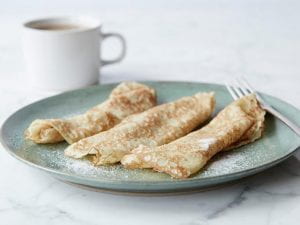
Iris, University of Oregon, Folklore and Public Culture Graduate Student:
This is a photo of one of the food cupboards in my kitchen. A lot of the items are some typical Dutch foods and/or breakfast items. This is something I eat on a regular basis. These are foods I have had all my life and I am glad there are places where we can get these items in the United States.
The top shelf:
- Bolletje: these are biscuit type things. Usually we will have this for lunch or breakfast. Anything could go on top of them. This is a Dutch brand we prefer, we buy it in bulk from a Dutch store in the United States that sells items online (a few other items in this photo are from there as well.
Middle shelf:
- Various teas: we all like drinking tea. My mom and I prefer black tea, but my sister likes different flavors.
Bottom shelf:
- Honey: Like to put it in our tea.
- Peanut butter: Put it on the crisp baker toasts or on sandwiches along with the chocolate sprinkles/flakes.
- De Ruijter milk chocolate sprinkles/flakes: these go on the crisp baker toasts or on bread with butter and/or peanut butter. This goes with a normal Dutch sandwich, something I still eat regularly. When I would bring this to school growing up and my classmates could not believe that my parents would let me eat it for lunch (it’s healthier than Nutella).
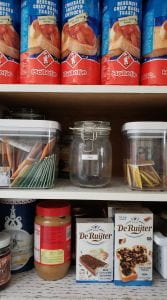
Jeremya, University of Oregon, Folklore and Public Culture Undergraduate Student:
The food item in my cupboard that I would like to share with you is Turkish coffee. This particular kind has cardamom in it, although not all do. Typically I would make it in a small pot called a “finjan”, and it is to be boiled in a special sequence. This bag is especially meaningful because it was sent to me by my family overseas. The lettering is Arabic and Hebrew. The smell is comforting, the fragrance representative of wisdom, story-telling, and the Middle East. Here is a photograph of my friends and I making this type of coffee last week while on a work break in the fields.


Alia, University of Oregon, Folklore and Public Culture Graduate Student:
Here is my fridge, folks. It’s pretty lean inside right now because I’ve been sick (pre-rona) and not had the energy to shop nor cook. I have a few fruits/veg and general staples like bread, yogurt, eggs, cheese, butter and condiments. The small white box on the top shelf on the left houses some skin products as well as some masks in the door. Condiments are fairly straight forward, salsa, pickles, olives, mustard etc. in the center of the top shelf is a glass water container..if you see the black ‘lump’ it is a piece of charcoal designed to extract/absorb impurities from water. whether that actually happens, ehh, the jury is out; but i still believe.
I don’t have anything on the outside face of the fridge, only my knife set on the side and some items on the top..dried flowers, candle, a drawing my niece made for me, a photo of me and my sister when she was a baby.



Alina Eugenia Tița:
I am going to start the Romanian traditional food post with our popular Beef Salad which is cooked/ served at every important Romanian holiday, such as Christmas and Easter. It is known as “Boeuf” Salad, meaning “Beef Salad” in French, but it actually is similar with the US potato salad, made with potatoes, pickled cucumbers, peppers, meat (pork, chicken and rarely beef), carrots, peas and mayo. It is served cold at festive meals. I will now let the Romanian team continue the posts about food because there is a lot to talk about …


EmaVio Tulpan, Romania Educator:
Happy New Year to all!
The celebrations are over, and I can now see the effect of the delicious foods served…
Our American partners probably have a pretty good idea by now of a Romanian feast, starting with entres (Alina’s beef salad) and continuing with the main dishes all meat (mainly pork) such as Simona’s sarmale and Nick’s mititei.
So I guess it’s time for some desert: the Cozonac. This is a kind of sweet bread typical to Romania, Bulgaria and Moldova – something similar would be Panettone or pulled bread. You cannot have a traditional holiday meal without this citrus-scented sweet dough twisted around a nutty cocoa filling. And a most filling desert it is, since it contains lots of eggs, butter, milk and sour cream besides the flour and sugar.
I will not give you a recipe because the process is really complex… and also because I never made one myself You really have to be an expert to get it right, so my mum makes it! But I can vouch for its perfect taste and aroma, especially when still warm from the oven. It is also very pleasant to the eye as the filling of your choice (mixture of sugar with walnut or cocoa powder or raisins or poppy seeds or colorful Turkish delight) forms a swirl and gives the loaf more character.
Here are pictures to prove.

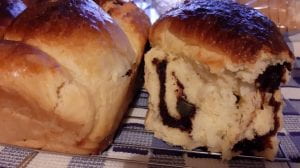
Andrei Cornea, Romania Graduate Student:
Hey everybody! My name is Andrei and I’m going to continue with another Romanian dessert.
It’s called papanasi and it’s a traditional dessert which comes from the Northern part of our country, even though you can find it in almost every restaurant around the country because it’s quite popular among all Romanians. This dessert is like a kind of fried cheese doughnut, with sweet or sour cream, usually blueberry jam, sometimes other kind of jams and it’s better to serve it hot!
Here is a photo of a papanasi with sour cream and blueberry jam:

Esther Stutzman, Oregon Artist:
I must be getting hungry because I am posting pictures of food.
One of the foods we eat on a consistent basis is fry bread. Today it is made with modern ingredients including yeast. But before the coming of the Europeans nearly all Native tribes had a version of a bread.
Here in the Willamette Valley of Oregon, the Kalapuya made cakes of Camas (a bulb-like plant) and they were cooked on flat rocks next to the fire.
As more and more modern ‘conveniences’ came into our lives, Fry Bread began changing so that some is made with baking powder and some is made with yeast. Our family prefers the kind made with yeast..
And…. of course there are adaptations of other food types with fry bread. We make “Indian Tacos” which is a piece of fry bread with everything on it that would be served on a Mexican taco.
One of things we do is to have fundraisers from the sale of fry bread and Indian Tacos. These fundraisers help to finance our summer Native Youth Camp.


Florin Gheorghiu, Romania Artist:
Greetings to lovers of sweets!!
A favorite dessert of my family and friends is the cheese pie and raisins that harmonize with the time we live! every time I enjoy it! here’s the recipe below!
In a bowl beat 6 eggs with the goal, add the vanilla sugar, the essences according to taste, lemon peel, and mix until homogenized. Then we add the sweet cheese, salted cheese given by grating, cream, sugar, gray and raisins and a homogeneous composition is obtained.
We prepare a tray that we anoint with a little oil, put half of the sheets one by one, greased each time with a little oil, in the middle put all the composition, then the remaining sheets. Top with two beaten eggs.
Always, before inserting the tray into the oven, the pie is sliced so that after it is browned, it is much easier to cut. ok.
Hot or cold, the pies are suitable with a dry red wine, for example with a Black Fetish or even with a Black Babe (Rare Black) ..
